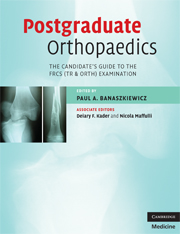Book contents
- Frontmatter
- Contents
- List of contributors
- Foreword by Mr Peter Gibson
- Preface
- Glossary
- Section 1 The FRCS (Tr & Orth) examination
- Section 2 The written paper
- Section 3 The clininicals
- Section 4 Adult elective orthopaedics oral
- 14 General oral guidance
- 15 Shoulder and elbow oral core topics
- 16 Hip oral core topics
- 17 Knee oral core topics
- 18 Foot and ankle oral core topics
- 19 Spine oral core topics
- Section 5 The hand oral
- Section 6 The paediatric oral
- Section 7 The trauma oral
- Section 8 The basic science oral
- Section 9 Miscellaneous topics
- Index
- References
16 - Hip oral core topics
from Section 4 - Adult elective orthopaedics oral
Published online by Cambridge University Press: 22 August 2009
- Frontmatter
- Contents
- List of contributors
- Foreword by Mr Peter Gibson
- Preface
- Glossary
- Section 1 The FRCS (Tr & Orth) examination
- Section 2 The written paper
- Section 3 The clininicals
- Section 4 Adult elective orthopaedics oral
- 14 General oral guidance
- 15 Shoulder and elbow oral core topics
- 16 Hip oral core topics
- 17 Knee oral core topics
- 18 Foot and ankle oral core topics
- 19 Spine oral core topics
- Section 5 The hand oral
- Section 6 The paediatric oral
- Section 7 The trauma oral
- Section 8 The basic science oral
- Section 9 Miscellaneous topics
- Index
- References
Summary
Anatomy of the hip
Blood supply of femoral head
This is a favourite question in either the basic science or the adult/pathology oral. This may lead into a discussion about avascular necrosis (AVN) of the femoral head. The blood supply has three sources:
Medial circumflex femoral artery is the most important supply; it is a branch of the profunda femoris artery
Lateral circumflex artery supplies the inferior portion; it is a branch of the profunda femoris artery
Artery of the ligamentum teres is a minor blood supply in the adult; it is a posterior branch of the obturator artery
The extracapsular arterial ring gives off ascending cervical arteries known as retinacular arteries. Injury to the retinacular arteries may lead to AVN.
Examination corner
Basic science oral 1
Second question after an initial discussion on the position that a leg assumes after a traumatic posterior and anterior dislocation of the hip.
Examiner: What is the blood supply to the femoral head?
Candidate: The blood supply to the femoral head is derived from the medial and lateral femoral circumflex arteries; these are branches of the profunda femoris artery. They form an extracapsular arterial ring around the base of the trochanter. Ascending cervical arteries are given off this ring and then branch into retinacular arteries, which form a subsynovial intracapsular arterial ring …
The candidate was stopped in mid-sentence by the examiner, who was satisfied with the answer and wanted to move on to another question. This led on to a discussion of AVN of the hip, types of THA to use in a young patient, survival analysis curves, etc.[…]
- Type
- Chapter
- Information
- Postgraduate OrthopaedicsThe Candidate's Guide to the FRCS (TR & Orth) Examination, pp. 155 - 193Publisher: Cambridge University PressPrint publication year: 2008



